Excellent Toughening of 2,6-Diaminopyridine Derived Poly (Urethane Urea) via Dynamic Cross-Linkages and Interfering with Hydrogen Bonding of Urea Groups from Partially Coordinated Ligands
Abstract
1. Introduction
2. Materials and Methods
2.1. Materials and Synthesis
2.2. Methods
2.2.1. Preparation of Films
2.2.2. Mechanical Properties Tests
2.2.3. Stress-Relaxation Tests
2.2.4. Fourier Transform Infrared Spectroscopy (FTIR)
2.2.5. UV-vis Spectroscopy
3. Results and Discussion
3.1. Mechanical Properties
3.2. FTIR Spectroscopic Analysis
3.3. UV-vis Spectroscopic Analysis
3.4. Analysis of Cyclic Tensile Tests
3.5. Analysis of Stress-Strain Behavior
3.6. Analysis of Stress Relaxation
3.7. Mechanism of Toughening
4. Conclusions
Author Contributions
Funding
Conflicts of Interest
References
- Velankar, S.; Cooper, S.L. Microphase Separation and Rheological Properties of Polyurethane Melts. 1. Effect of Block Length. Macromolecules 1998, 31, 9181–9192. [Google Scholar] [CrossRef]
- Garrett, J.T.; Runt, J.; Lin, J.S. Microphase Separation of Segmented Poly(urethane urea) Block Copolymers. Macromolecules 2000, 33, 6353–6359. [Google Scholar] [CrossRef]
- Furukawa, M.; Mitsui, Y.; Fukumaru, T.; Kojio, K. Microphase-separated structure and mechanical properties of novel polyurethane elastomers prepared with ether based diisocyanate. Polymer 2005, 46, 10817–10822. [Google Scholar] [CrossRef]
- He, Y.; Xie, D.; Zhang, X. The structure, microphase-separated morphology, and property of polyurethanes and polyureas. J. Mater. Sci. 2014, 49, 7339–7352. [Google Scholar] [CrossRef]
- Yang, L.; Shen, D.; Gao, S. Reinforcing and toughening of polyurethane by chemically modified Konjac glucomannan nanocrystal. Polym. Compos. 2017, 38, 1447–1453. [Google Scholar] [CrossRef]
- Amin, K.N.M.; Amiralian, N.; Annamalai, P.K.; Edwards, G.; Chaleat, C.; Martin, D.J. Scalable processing of thermoplastic polyurethane nanocomposites toughened with nanocellulose. Chem. Eng. J. 2016, 302, 406–416. [Google Scholar] [CrossRef]
- Jiang, L.; Zhang, C.; Liu, M.; Yang, Z.; Tjiu, W.W.; Liu, T. Simultaneous reinforcement and toughening of polyurethane composites with carbon nanotube/halloysite nanotube hybrids. Compos. Sci. Technol. 2014, 91, 98–103. [Google Scholar] [CrossRef]
- Wan, S.; Li, Y.; Peng, J.; Hu, H.; Cheng, Q.; Jiang, L. Synergistic Toughening of Graphene Oxide–Molybdenum Disulfide–Thermoplastic Polyurethane Ternary Artificial Nacre. Acs Nano 2015, 9, 708–714. [Google Scholar] [CrossRef] [PubMed]
- Lee, M.; Heo, M.H.; Lee, H.-H.; Kim, Y.-W.; Shin, J. Tunable softening and toughening of individualized cellulose nanofibers-polyurethane urea elastomer composites. Carbohydr. Polym. 2017, 159, 125–135. [Google Scholar] [CrossRef]
- Yao, X.; Qi, X.; He, Y.; Tan, D.; Chen, F.; Fu, Q. Simultaneous Reinforcing and Toughening of Polyurethane via Grafting on the Surface of Microfibrillated Cellulose. Acs Appl. Mater. Interfaces 2014, 6, 2497–2507. [Google Scholar] [CrossRef]
- Huang, J.; Zhang, L.; Tang, Z.; Guo, B. Bioinspired engineering of sacrificial bonds into rubber networks towards high-performance and functional elastomers. Compos. Commun. 2018, 8, 65–73. [Google Scholar] [CrossRef]
- Smith, B.L.; Schäffer, T.E.; Viani, M.; Thompson, J.B.; Frederick, N.A.; Kindt, J.; Belcher, A.; Stucky, G.D.; Morse, D.E.; Hansma, P.K. Molecular mechanistic origin of the toughness of natural adhesives, fibres and composites. Nature 1999, 399, 761–763. [Google Scholar] [CrossRef]
- Yount, W.C.; Loveless, D.M.; Craig, S.L. Strong Means Slow: Dynamic Contributions to the Bulk Mechanical Properties of Supramolecular Networks. Angew. Chem. Int. Ed. 2005, 44, 2746–2748. [Google Scholar] [CrossRef] [PubMed]
- Doig, A.J.; Williams, D.H. Binding energy of an amide-amide hydrogen bond in aqueous and nonpolar solvents. J. Am. Chem. Soc. 1992, 114, 338–343. [Google Scholar] [CrossRef]
- Liu, J.; Wang, S.; Tang, Z.; Huang, J.; Guo, B.; Huang, G. Bioinspired Engineering of Two Different Types of Sacrificial Bonds into Chemically Cross-Linked cis-1,4-Polyisoprene toward a High-Performance Elastomer. Macromolecules 2016, 49, 8593–8604. [Google Scholar] [CrossRef]
- Liu, J.; Liu, J.; Wang, S.; Huang, J.; Wu, S.; Tang, Z.; Guo, B.; Zhang, L. An advanced elastomer with an unprecedented combination of excellent mechanical properties and high self-healing capability. J. Mater. Chem. A 2017, 5, 25660–25671. [Google Scholar] [CrossRef]
- Yang, B.; Zhang, H.; Peng, H.; Xu, Y.; Wu, B.; Weng, W.; Li, L. Self-healing metallo-supramolecular polymers from a ligand macromolecule synthesized via copper-catalyzed azide–alkyne cycloaddition and thiol–ene double “click” reactions. Polym. Chem. 2014, 5, 1945–1953. [Google Scholar] [CrossRef]
- Jia, X.-Y.; Mei, J.-F.; Lai, J.-C.; Li, C.-H.; You, X.-Z. A self-healing PDMS polymer with solvatochromic properties. Chem. Commun. 2015, 51, 8928–8930. [Google Scholar] [CrossRef]
- Zhang, X.; Liu, J.; Zhang, Z.; Wu, S.; Tang, Z.; Guo, B.; Zhang, L. Toughening Elastomers Using a Mussel-Inspired Multiphase Design. Acs Appl. Mater. Interfaces 2018, 10, 23485–23489. [Google Scholar] [CrossRef]
- Filippidi, E.; Cristiani, T.R.; Eisenbach, C.D.; Waite, J.H.; Israelachvili, J.N.; Ahn, B.K.; Valentine, M.T. Toughening elastomers using mussel-inspired iron-catechol complexes. Science 2017, 358, 502–505. [Google Scholar] [CrossRef]
- Zhang, L.; Liu, Z.; Wu, X.; Guan, Q.; Chen, S.; Sun, L.; Guo, Y.; Wang, S.; Song, J.; Jeffries, E.M.; et al. A Highly Efficient Self-Healing Elastomer with Unprecedented Mechanical Properties. Adv. Mater. 2019, 31, 1901402. [Google Scholar] [CrossRef] [PubMed]
- Hong, G.; Zhang, H.; Lin, Y.; Chen, Y.; Xu, Y.; Weng, W.; Xia, H. Mechanoresponsive Healable Metallosupramolecular Polymers. Macromolecules 2013, 46, 8649–8656. [Google Scholar] [CrossRef]
- Zhang, Q.; Niu, S.; Wang, L.; Lopez, J.; Chen, S.; Cai, Y.; Du, R.; Liu, Y.; Lai, J.-C.; Liu, L.; et al. An Elastic Autonomous Self-Healing Capacitive Sensor Based on a Dynamic Dual Crosslinked Chemical System. Adv. Mater. 2018, 30, 1801435. [Google Scholar] [CrossRef] [PubMed]
- Wang, Z.; Xie, C.; Yu, C.; Fei, G.; Wang, Z.; Xia, H. A Facile Strategy for Self-Healing Polyurethanes Containing Multiple Metal–Ligand Bonds. Macromol. Rapid Commun. 2018, 39, 1700678. [Google Scholar] [CrossRef] [PubMed]
- Neal, J.A.; Mozhdehi, D.; Guan, Z. Enhancing Mechanical Performance of a Covalent Self-Healing Material by Sacrificial Noncovalent Bonds. J. Am. Chem. Soc. 2015, 137, 4846–4850. [Google Scholar] [CrossRef] [PubMed]
- Jutrzenka Trzebiatowska, P.; Santamaria Echart, A.; Calvo Correas, T.; Eceiza, A.; Datta, J. The changes of crosslink density of polyurethanes synthesised with using recycled component. Chemical structure and mechanical properties investigations. Prog. Org. Coat. 2018, 115, 41–48. [Google Scholar] [CrossRef]
- Luo; Wang; Ying. Hydrogen-Bonding Properties of Segmented Polyether Poly(urethane urea) Copolymer. Macromolecules 1997, 30, 4405–4409. [Google Scholar] [CrossRef]
- Lee, H.S.; Wang, Y.K.; Hsu, S.L. Spectroscopic analysis of phase separation behavior of model polyurethanes. Macromolecules 1987, 20, 2089–2095. [Google Scholar] [CrossRef]
- Coleman, M.M.; Sobkowiak, M.; Pehlert, G.J.; Painter, P.C.; Iqbal, T. Infrared temperature studies of a simple polyurea. Macromol. Chem. Phys. 1997, 198, 117–136. [Google Scholar] [CrossRef]
- Paik Sung, C.S.; Smith, T.W.; Sung, N.H. Properties of Segmented Polyether Poly(urethaneureas) Based of 2,4-Toluene Diisocyanate. 2. Infrared and Mechanical Studies. Macromolecules 1980, 13, 117–121. [Google Scholar] [CrossRef]
- He, Y.; Zhang, X.; Runt, J. The role of diisocyanate structure on microphase separation of solution polymerized polyureas. Polymer 2014, 55, 906–913. [Google Scholar] [CrossRef]
- El-Shazly, M.F.; El-Dissowky, A.; Salem, T.; Osman, M. Synthesis and electron spin resonance studies of copper(II) complexes with acid amide derivatives of 2-amino and 2,6-diaminopyridine. Inorg. Chim. Acta 1980, 40, 1–6. [Google Scholar] [CrossRef]
- Sadeek, S.A.; Refat, M.S. Synthesis, infrared spectra and thermal investigation of gold(III) and zinc(II) urea complexes. A new procedure for the synthesis of basic zinc carbonate. J. Coord. Chem. 2005, 58, 1727–1734. [Google Scholar] [CrossRef]
- Yılgör, E.; Yılgör, İ.; Yurtsever, E. Hydrogen bonding and polyurethane morphology. I. Quantum mechanical calculations of hydrogen bond energies and vibrational spectroscopy of model compounds. Polymer 2002, 43, 6551–6559. [Google Scholar] [CrossRef]
- Roecker, L.; Akande, J.; Elam, L.N.; Gauga, I.; Helton, B.W.; Prewitt, M.C.; Sargeson, A.M.; Swango, J.H.; Willis, A.C.; Xin, T.; et al. Synthesis, Characterization, and Reactivity of Urea Derivatives Coordinated to Cobalt(III). Possible Relevance to Urease. Inorg. Chem. 1999, 38, 1269–1275. [Google Scholar] [CrossRef] [PubMed]
- Rodgers, M.T.; Armentrout, P.B. Noncovalent metal-ligand bond energies as studied by threshold collision-induced dissociation. Mass Spectrom. Rev. 2000, 19, 215–247. [Google Scholar] [CrossRef]
- Li, C.H.; Wang, C.; Keplinger, C.; Zuo, J.L.; Jin, L.; Sun, Y.; Zheng, P.; Cao, Y.; Lissel, F.; Linder, C.; et al. A highly stretchable autonomous self-healing elastomer. Nat. Chem. 2016, 8, 618. [Google Scholar] [CrossRef] [PubMed]
- Li, J.; Ejima, H.; Yoshie, N. Seawater-Assisted Self-Healing of Catechol Polymers via Hydrogen Bonding and Coordination Interactions. Acs Appl. Mater. Interfaces 2016, 8, 19047–19053. [Google Scholar] [CrossRef] [PubMed]



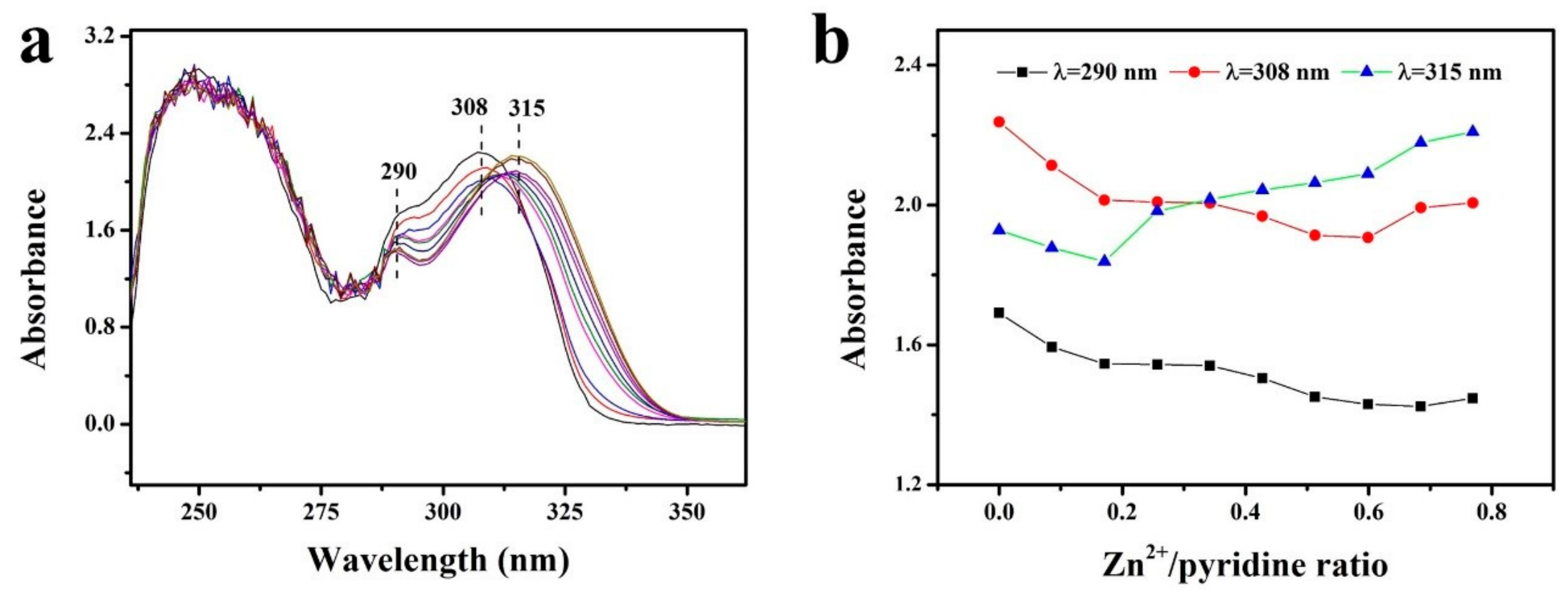
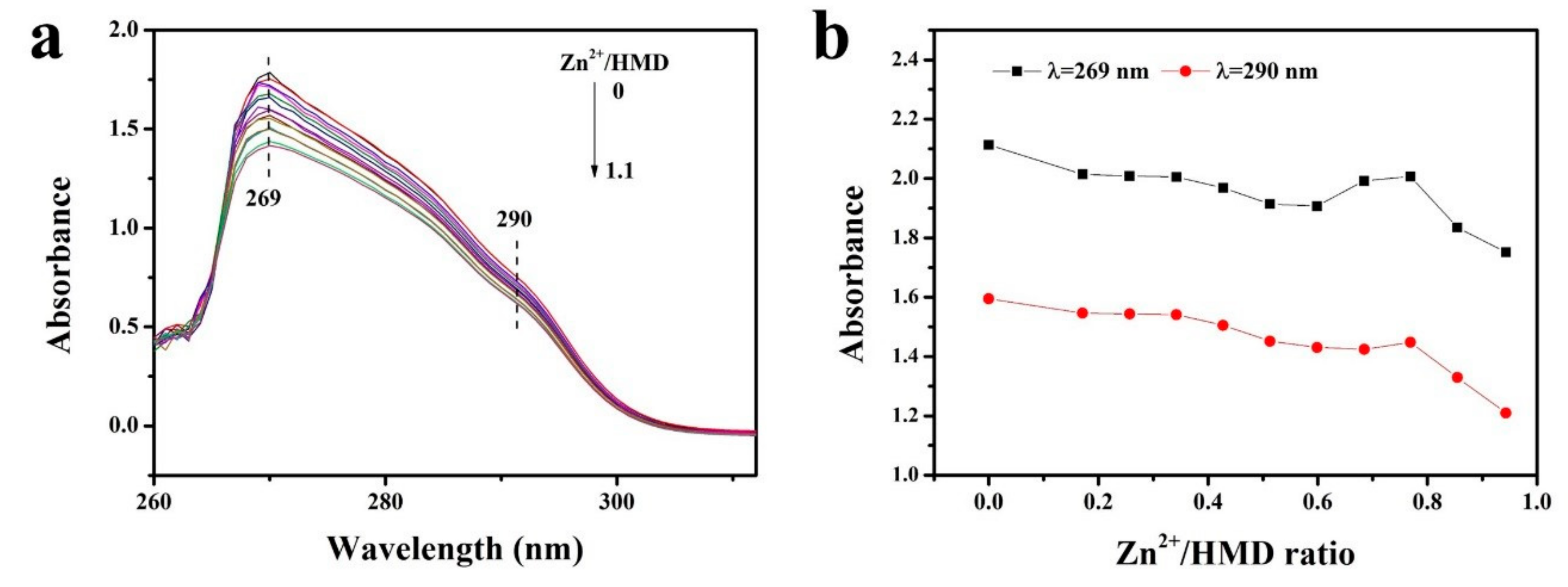
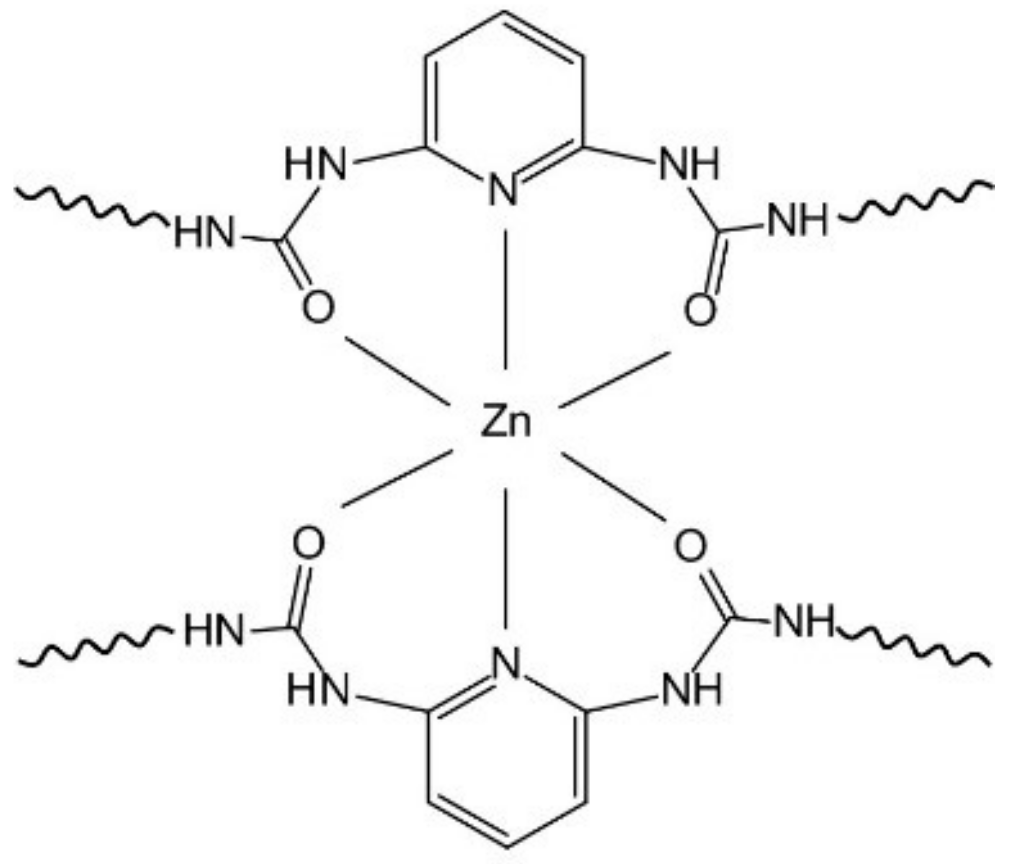
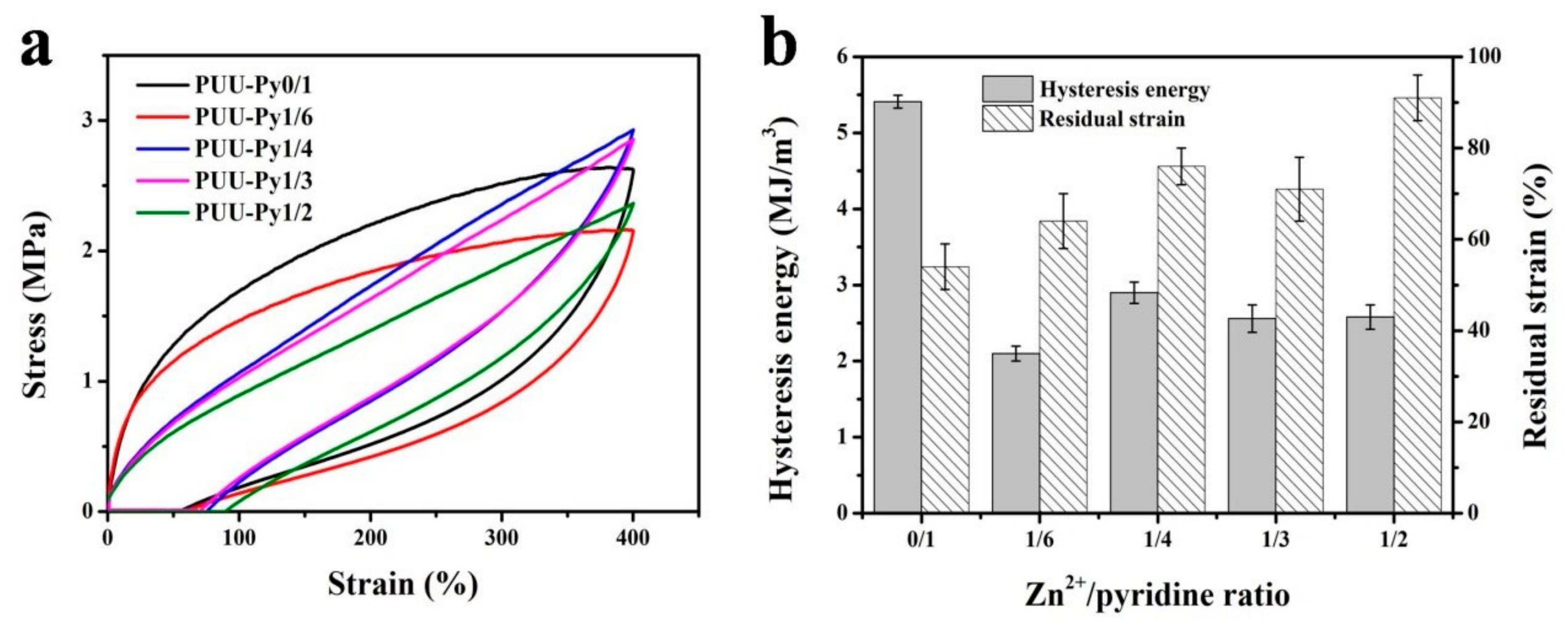
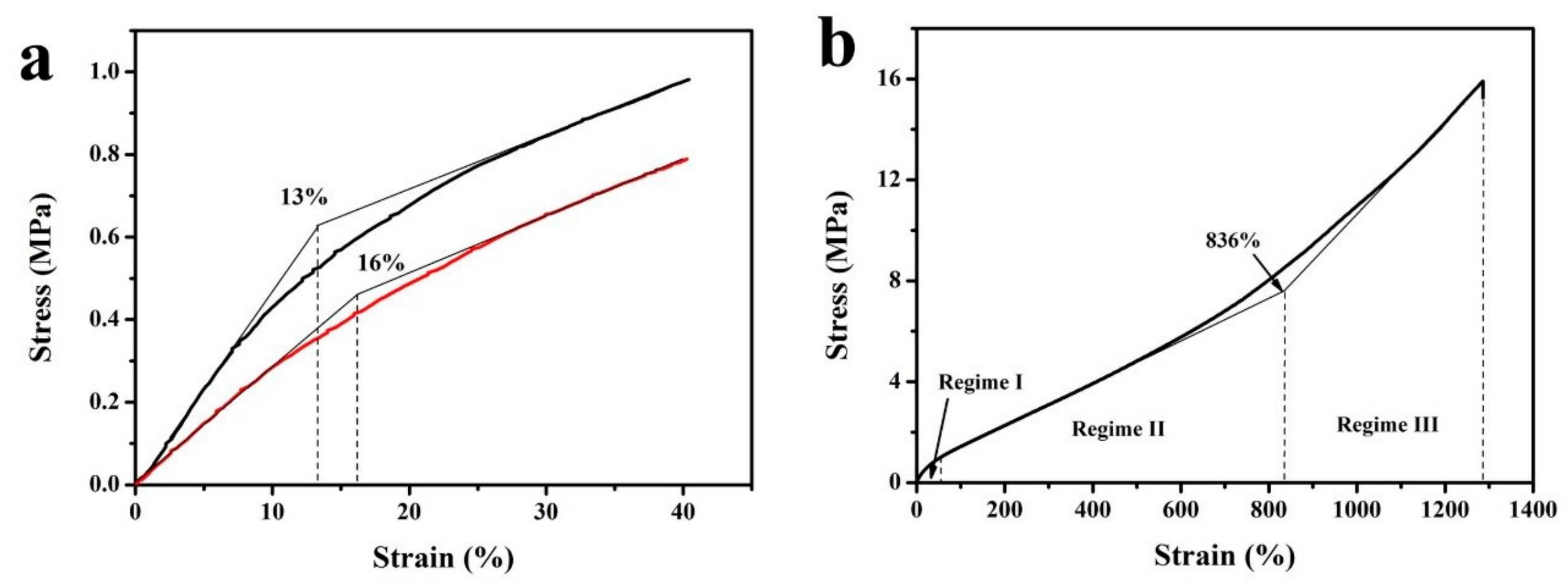
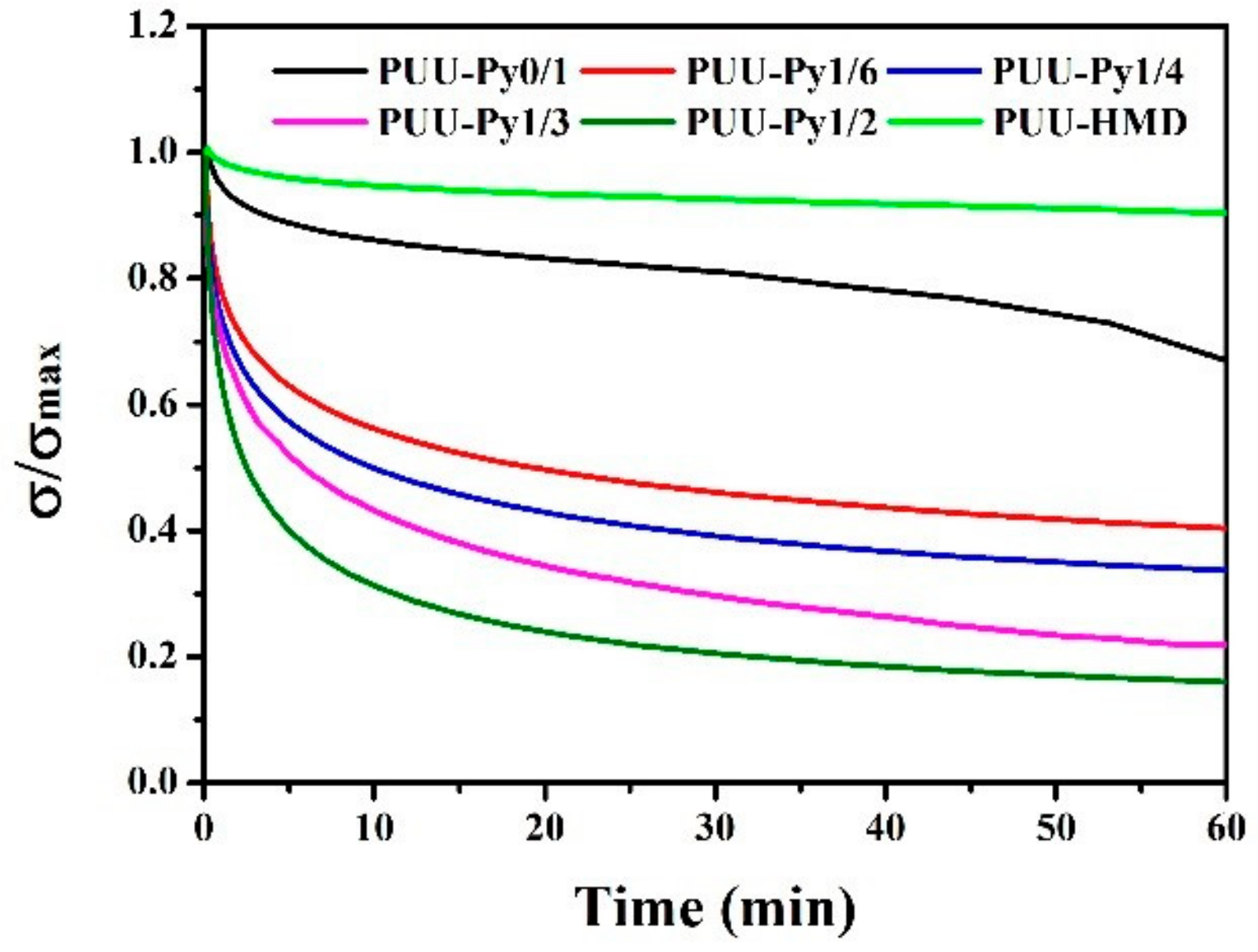

© 2019 by the authors. Licensee MDPI, Basel, Switzerland. This article is an open access article distributed under the terms and conditions of the Creative Commons Attribution (CC BY) license (http://creativecommons.org/licenses/by/4.0/).
Share and Cite
Sun, A.; Guo, W.; Zhang, J.; Li, W.; Liu, X.; Zhu, H.; Li, Y.; Wei, L. Excellent Toughening of 2,6-Diaminopyridine Derived Poly (Urethane Urea) via Dynamic Cross-Linkages and Interfering with Hydrogen Bonding of Urea Groups from Partially Coordinated Ligands. Polymers 2019, 11, 1320. https://doi.org/10.3390/polym11081320
Sun A, Guo W, Zhang J, Li W, Liu X, Zhu H, Li Y, Wei L. Excellent Toughening of 2,6-Diaminopyridine Derived Poly (Urethane Urea) via Dynamic Cross-Linkages and Interfering with Hydrogen Bonding of Urea Groups from Partially Coordinated Ligands. Polymers. 2019; 11(8):1320. https://doi.org/10.3390/polym11081320
Chicago/Turabian StyleSun, Ailing, Wenjuan Guo, Jinping Zhang, Wenjuan Li, Xin Liu, Hao Zhu, Yuhan Li, and Liuhe Wei. 2019. "Excellent Toughening of 2,6-Diaminopyridine Derived Poly (Urethane Urea) via Dynamic Cross-Linkages and Interfering with Hydrogen Bonding of Urea Groups from Partially Coordinated Ligands" Polymers 11, no. 8: 1320. https://doi.org/10.3390/polym11081320
APA StyleSun, A., Guo, W., Zhang, J., Li, W., Liu, X., Zhu, H., Li, Y., & Wei, L. (2019). Excellent Toughening of 2,6-Diaminopyridine Derived Poly (Urethane Urea) via Dynamic Cross-Linkages and Interfering with Hydrogen Bonding of Urea Groups from Partially Coordinated Ligands. Polymers, 11(8), 1320. https://doi.org/10.3390/polym11081320




